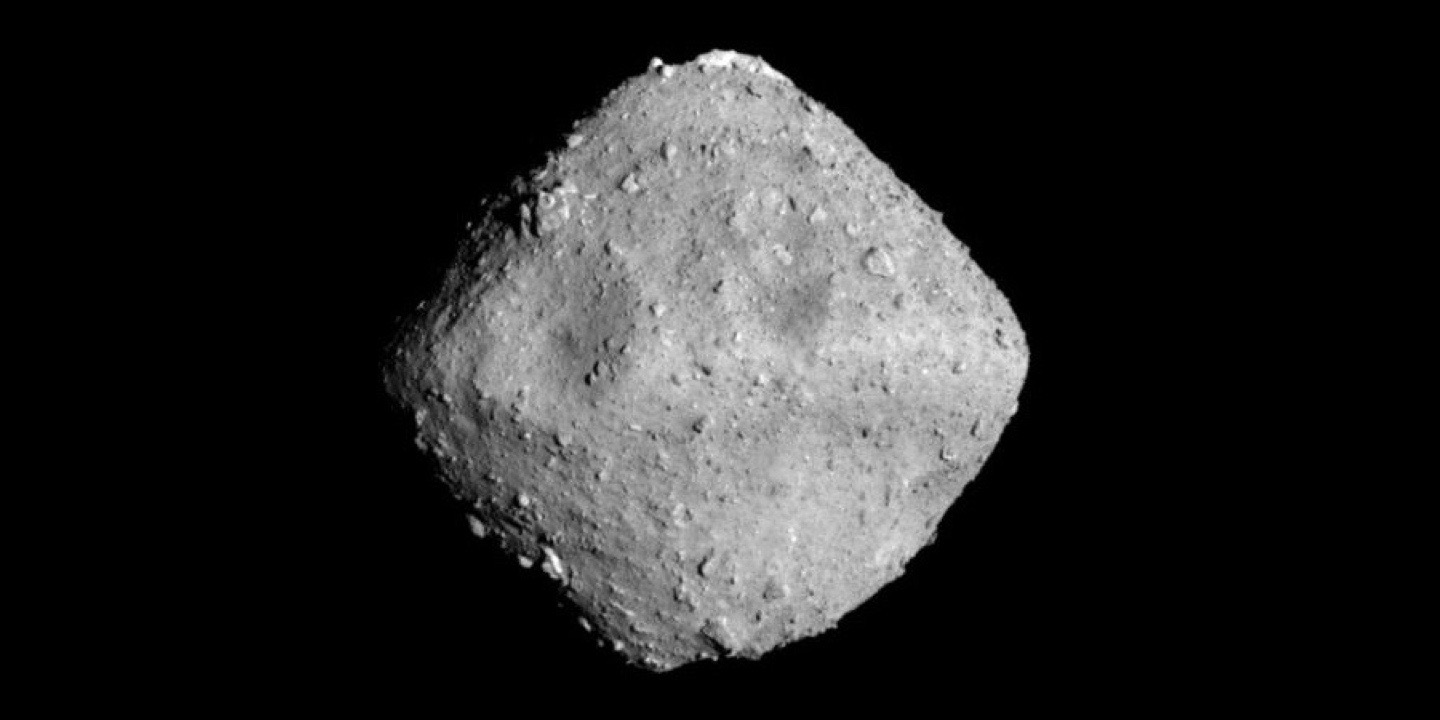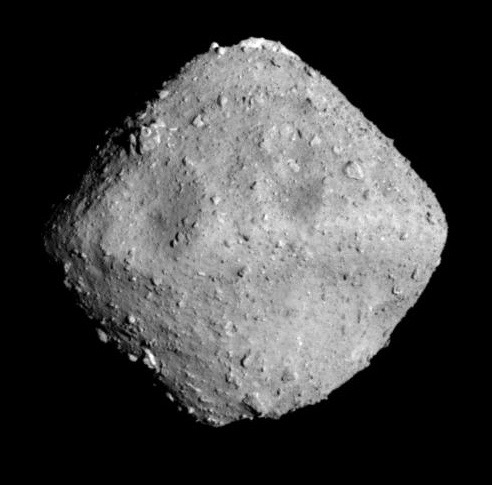A peregrine falcon in the underwater palace

The Japanese space probe Hayabusa2 has reached the asteroid Ryugu. Hayabusa means peregrine falcon in Japanese, Ryugu is the name of the dragon god’s underwater palace. The mission’s scientific team includes PlanetS researchers. Martin Jutzi calculates what happens when an impactor knocks out an artificial crater on the asteroid. Henner Busemann hopes to be able to once again examine samples of the collected material, just as he did during the first Hayabusa mission.

Asteroid Ryugu imaged on June 26, 2018. (Image: JAXA, University of Tokyo, Kochi University, Rikkyo University, Nagoya University, Chiba Institute of Technology, Meiji University, University of Aizu, AIST)
The photos of the asteroid Ryugu show a spinning-top-shaped body, almost one kilometre in size with a mountain-like ridge around the equator. “A similar form has already been found for other asteroids on the basis of radar observations,” says Martin Jutzi, senior researcher at the University of Bern. If such a body rotates fast enough, material can be ejected and form a moon orbiting around the asteroid.” As the probe has been approaching its destination in recent weeks, we have repeatedly speculated about this question in emails,” says Jutzi. Despite intensive observations, the Japanese space agency JAXA has not been able to locate a satellite so far. This is good news for the Hayabusa2 mission as a collision with even the smallest moon could mean the end of the mission.
Scientists are particularly interested in the shape of asteroids and comets because they allow conclusions to be drawn about their formation and in turn the history of our solar system. Using computer simulations, Jutzi calculates possible scenarios such as break-up due to rotation or collisions. “Exactly how the particular shapes of small bodies form is a very current research topic”, says the PlanetS researcher. It is now generally assumed that asteroids larger than 100 kilometres still have their original structure, while small bodies have often been destroyed and reshaped.
Hayabusa2 was launched in December 2014, and after a journey of more than 3 billion kilometres, the space probe, weighing in at over 600 kilograms, reached its destination on 27 June, 2018. Now it is to release a landing device built by the German Aerospace Center (Deutsches Zentrum für Luft- und Raumfahrt; DLR). If everything goes according to plan, the shoe-box-sized “MASCOT” lander will hop over the asteroid surface collecting data on temperature and magnetisation as well as analysing rocks.
Simulating the impact of a 2 kg projectile
As a member of the Hayabusa2 science team, Martin Jutzi is calculating what will happen during a later phase of the mission. In spring 2019 a 2 kg impactor will be shot to create a crater on the asteroid in order to obtain material from below the surface. The predictions of the computer simulations should not only help in planning the project, but also allow scientists to draw conclusions about the asteroid’s surface properties. Jutzi is working together with Japanese colleagues who carry out corresponding experiments in the laboratory. “However, one difficulty will be to actually find the small crater after the impact,” says the Bernese researcher.
The Japanese space probe should also collect soil samples using a sampler horn and bring them back to Earth in 2020. Although the yield was extremely low, back in 2010 the previous Hayabusa mission already succeeded in supplying researchers with asteroid material for the first time ever. “For a foreign team, we were awarded a large number of particles,” recalls PlanetS scientist Henner Busemann. He conducted research at the University of Manchester and led an international consortium that included the universities of Manchester and Lund, DLR Berlin and, in Switzerland, the ETH Zurich and the Paul Scherrer Institute. Busemann, who now works at the ETH Institute of Geochemistry and Petrology, explains that the precious material arrived in nice, well-padded small suitcases in Manchester and then in Zurich.
Determining the abundance of noble gases
The analysed samples from the asteroid Itokawa consisted mainly of olivine, an iron-magnesium-silicate which is also frequently found on Earth, and pyroxene. The tiny particles were less than 50-100 micrometers in size. In Manchester and Zurich, Henner Busemann tried to detect the noble gases xenon, helium and neon and to determine their isotope fractions. This information can be used to calculate how long the sample and thus the material on the surface of the asteroid was exposed to cosmic radiation. In a first study, the particles examined seemed to have been irradiated for a maximum of only 8 million years. “That would have meant that the material was young and erosion was high,” Busemann sums up and concludes: “Itokawa would not have survived a billion years in space”. Recent analyses of further particles now yield much higher, more expected irradiation ages.
“Of course we hope that we will also receive samples from Hayabusa2”, says Henner Busemann. The new mission should not only bring more material back to Earth, but also provide more concrete conclusions from over a longer period of time. In contrast to Itokawa which formed closer to the sun, Ryugu belongs to a group of asteroids that probably originated further away from the sun and contain more porous material that has remained more original. “We will examine interactions between minerals, water and organic matter in the young solar system to learn more about the origin and development of the Earth, the oceans and life,” JAXA writes confidently.
http://www.hayabusa2.jaxa.jp
https://twitter.com/haya2e_jaxa
DLR: Preparing for an asteroid landing

